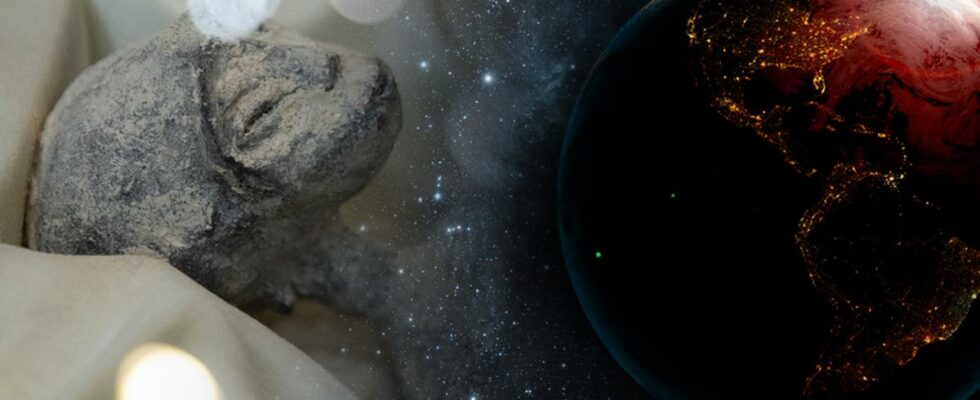unsaveSave
expand-left
full screen One of the two bodies on display to the media. Photo: Stella Pictures/Ddp/Abaca Press
Foreign bodies found in Peru.
Now fingerprints are said to show they are not human.
– The fingerprints did not have traditional human patterns, claims UFO researcher Joshua McDowell.
ⓘ The summary is made with the support of AI tools from OpenAI and quality assured by Aftonbladet. Read our AI policy here.
Show more
chevron-down
The mystery surrounding the controversial mummified bodies in Peru thickens.
The fingerprints are said to be diagonal grooves along the fingertips and likewise the prints on the toes, unlike the circular prints we are used to.
The UFO researcher, American defense attorney Joshua McDowell, has according to Daily Mail examined over half a dozen “alien” remains together with three independent forensic experts from the United States.
In addition to McDowell, a medical examiner from Denver and a forensic anthropologist from Maryland’s state medical examiner were on the trip to Peru. The third expert was McDowell’s father Dr. John McDowell, a forensic odontologist from the University of Colorado who previously, among other things, worked with identifying victims after the terrorist attacks in New York via dental records.
expand-left
full screen The mummified figures have three fingers on each hand. Photo: Stella Pictures/Ddp/Abaca Press
As early as 300 BC, fingerprints were used in China, according to the US Department of Justice’s “Fingerprint Saucebook”. Forensic investigators in the United States have since systematized the hunt for unique prints, epidermal ridges, since they began to be used by American police in 1902. These are arcs, loops and whorls.
Low in fossil stone flour
One of the bodies found in Peru, named Maria, did not appear to have fingerprints that matched any known window, according to the four experts.
– We saw no arcs, loops or eddies. Neither on fingers or toes. I have been a prosecutor, I am a criminal lawyer. I’ve seen loads of fingerprints – and these weren’t classic fingerprints, says McDowell.
– Maria’s fingerprints were not comparable to human fingerprints.
expand-left
fullscreen The Nazca Lines of Peru were created between 500 B.C. and 500 AD of the Nasca people. Why no one knows. Photo: Diego Delso/Wikipedia Commons
The remains were first found by ufologist Jaime Maussan – who in the past year is said to have discovered over half a dozen “alien” mummies – in a layer of diatomaceous earth, fossil rock meal, in Peru.
– Large parts of her body are covered in diatomaceous earth, but on the exposed fingers the epidermal ridges appeared to consist mostly of straight lines, says McDowell.
But the expert group, which traveled together to Peru, does not want to draw any definitive conclusions.
Looking for explanations
According to McDowell, there may still be an earthly explanation for the unusually straight friction ridge patterns on Maria’s fingers and toes.
– It could possibly have something to do with how her skin was preserved. It is very strange, he tells the Daily Mail.
Joshua McDowell emphasized that “no conclusion has been reached as to what the mummies are yet” and he added that the entire team is still working to identify these “alien” mummies.
Maria is one of several bodies known as the Nazca mummies after the area in southwestern Peru where the bodies are said to have been found.
The bodies have become famous, thanks in part to their elongated heads and their three-fingered hands. The appearance is consistent with anecdotal accounts of extraterrestrial beings.
expand-left
fullscreen A team of researchers tries to find explanations, but Peru’s Department of Culture dismisses the mummies as dolls. Photo: Stella Pictures/Ddp/Abaca Press
Dismissed as a scam
Peru’s Ministry of Culture has described the mummies as human-made hoaxes. In January, Flavio Estrada, a forensic archaeologist from the Institute of legal medicine and forensic sciences of Lima, said at a press conference that two of the mysterious bodies were “dolls.”
– The conclusion is simple. The dolls have been put together with animal bones from this planet with modern synthetic glue, therefore they were not put together in pre-Hispanic times, he said at the time.
Maria first became known during a press conference at Peru’s San Luis Gonzaga national university of Ica on November 6, 2019, along with three other Nazcam mummies: Wawita, Albert and Victoria.
Maussan has also published a report on the mummies’ DNA, writes the Daily Mail. According to DNA samples taken from the mummies, 29 percent is DNA that is not in the evolutionary chain on Earth.
